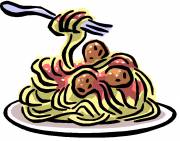 Heard of World Pasta Day? I hadn’t, or at least I hadn’t remembered hearing about it, until I received what is destined to become an award-winning news release from the much maligned Canadian Wheat Board, heralding October 25 as the day all earthlings celebrate the roots of spaghetti. The release showed wheat board types can gave fun like the rest of us and when their backs aren’t up against the wall trying to shoo away the federal government, and that they have a real sense of humour.
Heard of World Pasta Day? I hadn’t, or at least I hadn’t remembered hearing about it, until I received what is destined to become an award-winning news release from the much maligned Canadian Wheat Board, heralding October 25 as the day all earthlings celebrate the roots of spaghetti. The release showed wheat board types can gave fun like the rest of us and when their backs aren’t up against the wall trying to shoo away the federal government, and that they have a real sense of humour.
In the release, the wheat board, which the federal Conservatives are trying to bring to its knees so farmers can export their own grain, implored Canadians to “Support a Prairie spaghetti farmer.” It’s a departure from the usual kind of news the board generates, and the depiction of western grain producers as spaghetti farmers, the day itself as a “true spaghetti western” and a reference to the “spaghetti harvest” is an unusually light approach for the normally staid wheat board.
But with World Pasta Day, it has some good material to work with. World Pasta Day was established as an annual event at the first World Pasta Congress on October 25, 1995 in, where else, Italy. It occurs every year the day after National Bologna Day, and the day before National Mincement Day.
As the board points out, pasta is often associated with Italy. But, it adds, some of the world’s best pasta is made from prairie-grown Canada Western Amber Durum, which is milled into semolina flour as the main pasta ingredient. Some eastern Canadians, such as the local seed company C&M Seeds, are trying to change that by developing durum wheat that grows well in Ontario too, and is making progress in getting farmers to believe in it and grow it.
But at this point, prairie farmers rule when it comes to durum wheat. They plant about five million acres each year, making it Canada’s fourth-largest grain crop (behind spring wheat, canola and barley). The wheat board sells that durum wheat abroad; in fact, it’s the world’s largest exporter of durum, holding up to 60 per cent of the world’s market share in any given year.
So when it starts calling durum wheat producers spaghetti farmers, it doesn’t do it lightly. It’s trying to make itself more accessible to Canadians, from whom it needs support to convince the Harper government that it should continue having exclusive rights over export wheat. To that end, it’s launched a new website full of pasta recipes, www.prairiewheat.ca, and a downloadable version of its 70th anniversary cookbook, to get a little closer to the public.
But the spaghetti farmer approach underlines a fundamental and vitally important change in thinking at the mother corps of Canadian grain – that is, think about the end user. It’s not farmers, and it’s not even processors, it’s consumers.
Besides generating warm and fuzzy feelings (which really, aren’t so bad), the terms grain grower and wheat producer don’t mean a lot to consumers. They make a vague connection to consumers’ kitchens, but they’re much more centred on where wheat comes from, rather than where it’s going.
Spaghetti farmer, though, is very clear. In the etched-in-stone words of Elora food activist Anita Stewart, farmers grow ingredients, not commodities. Despite its importance to the Canadian food chain, durum wheat is a non-starter with most consumers. But spaghetti? Now you’re onto something.
So congratulations Canadian Wheat Board for this latest attempt to make a consumer connection. The importance of joining farmers and consumers can’t be stated enough. And it’s all the more meaningful and resonant when it comes from an industry giant like you.
-30-

